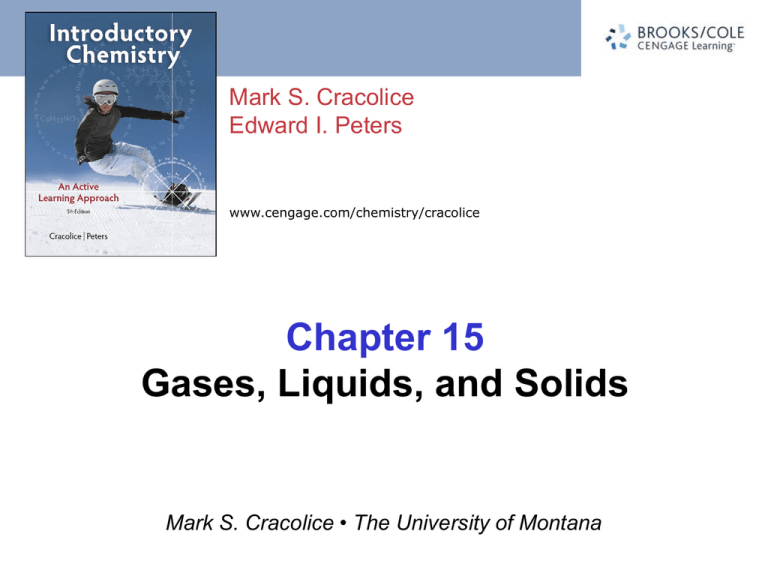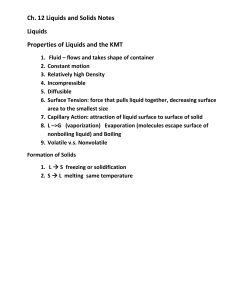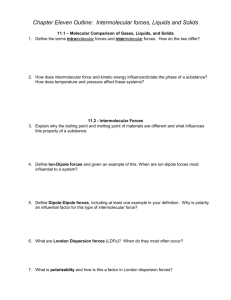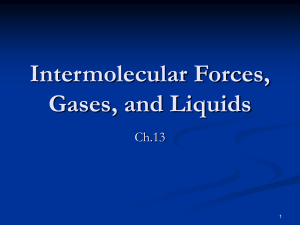Types of Intermolecular Forces
advertisement

Mark S. Cracolice Edward I. Peters www.cengage.com/chemistry/cracolice Chapter 15 Gases, Liquids, and Solids Mark S. Cracolice • The University of Montana Dalton’s Law of Partial Pressures Dalton’s Law of Partial Pressures The partial pressure of a component in a gas mixture is the pressure that component would exert if it alone occupied the same volume at the same temperature. The total pressure exerted by a mixture of gases is the sum of the partial pressures. Ptotal = p1 + p2 + p3 + p4 +---- Dalton’s Law of Partial Pressures Example: The partial pressures in a mixture of gases are: Helium, 344 torr Neon, 298 torr Argon, 109 torr What is the total pressure? Solution: P = p1 + p2 + p3 = pHe + pNe + pAr = (344 + 298 + 109) torr = 751 torr Laboratory Collection of Oxygen • A mixture of oxygen and water vapor are collected at 220C, at which water vapor pressure is 19.8 torr. If the total pressure of the mixture is 755 torr, what is the oxygen pressure? Laboratory Collection of Oxygen Ptotal = Patm when the water levels are equalized. Poxygen = Ptotal – Pwater vapor = 755 torr – 19.8 torr = 735 torr Properties of Liquids Comparison of Properties of Liquids with Properties of Gases 1. Gases may be compressed; liquids cannot. 2. Gases expand to fill their containers; liquids do not. 3. Gases have low densities; liquids have relatively high densities. 4. Gases may be mixed in a fixed volume; liquids cannot. Properties of Liquids Gas particles are far apart. Forces between the particles are negligible. In a liquid, the particles are very close to one another. The intermolecular attractions in a liquid are strong. Properties of Liquids: Vapor Pressure The partial pressure exerted by a vapor in equilibrium with its liquid phase is the vapor pressure. The stronger the intermolecular forces, the lower the vapor pressure. The vapor pressure is higher at higher temperature. Properties of Liquids: Vapor Pressure Properties of Liquids: Heat of Vaporization The energy required to vaporize one gram of substance is called heat of vaporization (the unit is kJ/g) The energy required to vaporized one mole is called molar heat of vaporization (the unit is kJ/mol). The stronger the intermolecular attraction, the higher the molar heat of vaporization. . Properties of Liquids: Heat of Vaporization Properties of Liquids: Boiling Point Boiling point is the temperature at which the vapor pressure of a liquid is equal to the external pressure above its surface. The temperature at which the vapor pressure is equal to one atmosphere is called the normal boiling point. Properties of Liquids: Boiling Point Properties of Liquids: Boiling Point In order for a stable bubble to form in a boiling liquid, the vapor pressure within the bubble must be high enough to push back the surrounding liquid and the atmosphere above the liquid The boiling point of a substance increases with the surrounding pressure. Properties of Liquids Properties of Liquids: Viscosity Viscosity A measure of the resistance of a liquid to flow. The stronger the intermolecular attractive forces, the greater the resistance to flow, so the higher the viscosity. Properties of Liquids: Viscosity A measure of the resistance of a liquid to flow. water<syrup<honey Properties of Liquids: Surface tension Surface Tension The tendency for a liquid to form the minimum possible surface area. The stronger the intermolecular attractive forces, the stronger each particle is attracted in all directions by the particles around it, so the higher the surface tension. Properties of Liquids: Surface Tension Molecules at the surface possess a higher potential energy than those within the body of the liquid. To minimize this energy, a liquid tends to have minimum surface. Three Kind of Intermolecular Forces Dipole forces Induced dipole forces Hydrogen bonds Of the three kinds of intermolecular attractions, hydrogen bonds are the strongest. Dipole forces are next, and dispersion forces are the weakest. Types of Intermolecular Forces Dipole Forces Polar molecules have permanent dipole moments. The dipole force is the force of attraction between the positive pole of one molecule and the negative pole of another molecule. Types of Intermolecular Forces Types of Intermolecular Forces Types of Intermolecular Forces: Induced Dipole Forces Induced Dipole: The presence of an external electric field may cause an induced, or temporarily, polarization of the molecule. Molecules in which a dipole can be induced in this way are said to be polarizable. Attractions between induced dipoles are also called dispersion forces. Types of Intermolecular Forces: Induced Dipole Forces Attractive forces between instantaneous electric dipoles on neigbboring molecules Types of Intermolecular Forces Induced Dipole Forces Large molecules are more easily polarized than small molecules. Induced dipole forces increase with molar mass Br2 molecules have 70 electrons. Bromine (left) is a liquid. Iodine, I2 , molecules have 106 e Iodine (right) is a solid. . Types of Intermolecular Forces Hydrogen bonds The covalent bond between hydrogen atom and atom of nitrogen, oxygen, or fluorine is strongly polar. Types of Intermolecular Forces: Hydrogen bonds Hydrogen bonds: The attractive forces between molecules that have a hydrogen atom covalently bonded to nitrogen, oxygen, or fluorine atom. Hydrogen atom lies between two small strongly electronegative atoms with lone pairs of electrons. A hydrogen bond is an intermolecular force, an attraction between hydrogen atom of one molecule with the negative pole of another molecule. Types of Intermolecular Forces: Hydrogen bonds between H2O molecules A hydrogen bond is denoted by dots to distinguish it from a covalent bond. The Solid State Solid substances can be classified based on how the particles are arranged in the solid: Crystalline Solid Particles are arranged in a geometric pattern that repeats itself over and over in three dimensions. Amorphous Solid No long-range ordering of the particles in the solid. The Solid State The Solid State Crystalline Solid and amorphous solid Types of Crystalline Solids Crystalline solids can be divided into four classes on the basis of the type of forces that hold particles together in the crystal lattice: Ionic crystals Molecular crystals Covalent network solids Metallic crystals Types of Crystalline Solids: Ionic Crystals Ionic Crystals Ionic crystals have ions at the points of the lattice that describes the structure of the solid. Examples are sodium chloride, calcium carbonate. Ionic Crystals: NaCl Ionic Crystals: CaCO3 Molecular Crystals Molecular Crystals A molecular solid has covalently bonded molecules at each of its lattice points. Examples are sugar, I2, S8 Molecular Crystal of Sulfur Molecular Crystal of S8 and liquid form of sulfur Covalent Network Solids Covalent Network Solids The atoms bond to each other with strong directional covalent bonds that lead to giant molecules, or networks, of atoms. Examples are diamond, graphite, quartz. Diamond Covalent Network Solids: Quartz Covalent Network Solids: Quartz Types of Crystalline Solids: Metallic Crystals Metallic Crystals A crystal of positive ions through which valence electrons move freely. Examples: Al, Cu, Fe Metallic Crystal Metal ions in an electron sea Metallic Crystal: Aluminum Metal Properties of Crystalline Solids Energy and Change of State Energy and Change of State: Vaporization To boil a liquid (vaporization), heat must be added. For a pure substance at its boiling point, the amount of heat added to vaporize the liquid is proportional to the mass of the liquid: q = ∆Hvap x m ∆Hvap is the enthalpy of vaporization or the heat of vaporization. Energy and Change of State Energy and Change of State Example: How much energy is required to vaporize 19.6 g of water at 100°C? Solution: Solve with algebra. GIVEN: 19.6 g; ∆Hvap = 2.26 kJ/g (Table 15.4) WANTED: Energy (assume kJ) 2.26 kJ q = m H vap = 19.6 g = 44.3 kJ g Energy and Change of State To melt a solid (fusion), heat must be added. For a pure substance at its melting point, the amount of heat added to melt the solid is proportional to the mass of the solid: q = ∆Hfus x m ∆Hfus is the enthalpy of fusion or the heat of fusion. Energy and Change of State Example: How much energy is required to melt 19.6 g of ice at 0°C? Solution: Solve with algebra. GIVEN: 19.6 g; ∆Hfus = 333 J/g (Table 15.4) WANTED: Energy (assume kJ) q = m H fus 333 J 3 = 19.6 g = 6.53 10 J g Energy and ∆T: Specific Heat Experiments indicate that the heat flow, q, in heating or cooling a substance is proportional to the mass, m, and its temperature change, ∆T q = m x c x ∆T C is the specific heat of the substance Energy and ∆T: Specific Heat q c º m ´ ∆T Specific Heat, c The heat flow required to change the temperature of one gram of a substance by one degree Celsius. A substance with a low specific heat gains little energy in warming through a temperature change, as compared with a substance with a higher specific heat. Energy and ∆T: Specific Heat Energy and ∆T: Specific Heat Example: How much energy is required to change the temperature of 25.0 g of water from 10.0°C to 50.0°C? Solution: Solve with algebra. GIVEN: 25.0 g; c = 4.18 J/g • °C (Table 15.5) WANTED: Energy (assume J) 4.18 J 25.0 g ´ ´ (50.0 – 10.0)°C = 4.18 ´ 10 3 J g × °C Changes in Temperature & State If you steadily apply heat to a pure substance in the solid state, five things will happen: 1. The solid will warm to its melting point temperature. 2. The solid will change to liquid at the melting point temperature. 3. The liquid will warm to its boiling point temperature. 4. The liquid will change to gas at the boiling point temperature. 5. The gas will become hotter. Changes in Temperature & State Changes in Temperature & State Example: Calculate the energy that must be added to 19.6 g of ice at –12°C to change it to steam at 115°C. Answer in kJ. Solution: Step 1 is to sketch a graph of temperature vs. heat flow. Changes in Temperature & State Step 2 is to calculate the heat flow for each step. A to B: Solid at –12°C to solid at 0°C GIVEN: 19.6 g; c = 2.06 J/g • °C (Table 15.5) WANTED: Energy in kJ 2.06 J 1 kJ Q(A B) 19.6 g [0 — (—12)]C = 0.48 kJ g C 1000 J Changes in Temperature & State B to C: Solid at 0°C to liquid at 0°C GIVEN: 19.6 g; ∆Hfus = 333 J/g (Table 15.4) WANTED: Energy in kJ 333 J 1 kJ Q(B C) 19.6 g = 6.53 kJ g 1000 J Changes in Temperature & State C to D: Liquid at 0°C to liquid at 100°C GIVEN: 16.9 g; c = 4.18 J/g • °C (Table 15.5) WANTED: Energy in kJ 4.18 J 1 kJ Q(C D) 16.9 g (100 — 0)C = 8.19 kJ g C 1000 J Changes in Temperature & State D to E: Liquid at 100°C to gas at 100°C GIVEN: 19.6 g; ∆Hvap = 2.26 kJ/g (Table 15.4) WANTED: Energy in kJ 2.26 kJ Q(D E) 19.6 g = 44.3 kJ g Changes in Temperature & State E to F: Gas at 100°C to gas at 115°C GIVEN: 19.6 g; c = 2.00 J/g • °C (Table 15.5) WANTED: Energy in kJ 2.00 J 1 kJ Q(E F) 19.6 g (115 - 100)C = 0.59 kJ g C 1000 J Changes in Temperature & State Step 3 is to add the heat flows. qtotal = qA to B + qB to C + qC to D + qD to E + qE to F = 0.48 kJ + 6.53 kJ + 8.19 kJ + 44.3 kJ + 0.59 kJ = 60.1 kJ







